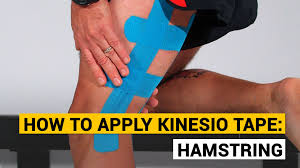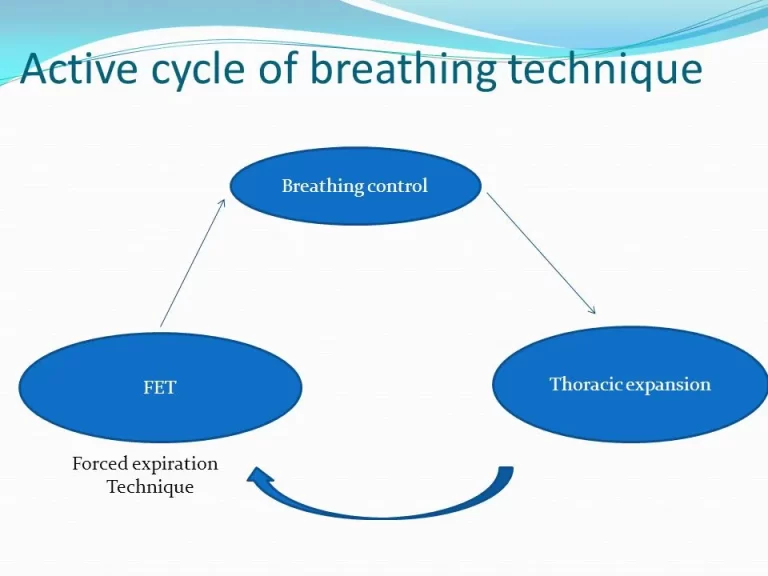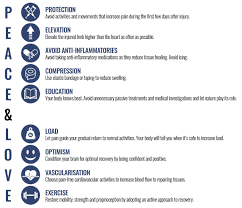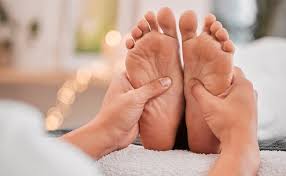Kinesiology Taping for Hamstrings
Introduction
Kinesiology taping for hamstrings is a therapeutic method in which elastic tape is applied directly to the skin to support muscles and joints and preserve the range of motion. Kinesiology tape was first created in the 1970s by Japanese chiropractor Dr. Kenzo Kase, and because of its non-invasive nature and adaptability in treating a range of musculoskeletal problems, it has become widely used in sports medicine and rehabilitation.
Additionally, kinesiology taping can facilitate lymphatic and blood flow to the injured area, thereby accelerating healing and minimizing swelling. The tape improves fluid dynamics by creating a space that gives a grant for enhanced skin elevation from the underlying tissues. This space facilitates the elimination of metabolic waste products and enhances the delivery of oxygen and nutrients to the wounded tissues.
The hamstring muscle is thought to be crucial for both stabilizing posture and allowing lower limb mobility. Running, walking, and jumping are just a few of the daily actions that rely heavily on the hamstring muscle. The hamstring muscle’s primary job during the gait cycle is to help stabilize and initiate movement in the knee joint. Because the hamstring muscle has several joints and serves a range of purposes, it is subject to numerous tensional stresses, which causes the muscle to shorten. People who spend a lot of time sitting down, like desk workers and students who have poor posture when studying, and those who don’t exercise much are more likely to experience postural spine curvature issues and hamstring tightness.
Athletes and people participating in physical activities requiring sprinting, jumping, or quick direction change frequently sustain hamstring injuries. If these injuries are not properly managed, they may cause pain, impair movement, and potentially need longer healing times. As an effective additional treatment for hamstring strains, kinesiology tape provides pain relief, support, and optimal muscle function while the injury heals.
Kinesiology tape is useful for hamstring problems for several reasons. First, it continuously lessens pain by gently stimulating the skin and underlying tissues. This can improve proprioception and lessen nociceptive input. Furthermore, the tape’s elastic qualities enable it to support the injured muscle without excessively limiting movement, promoting a more organic and useful gait when engaging in exercises like running, jumping, or walking.
The fundamentals of kinesiology tape for hamstring problems will be covered in this article, along with advice on applying it properly and maximizing its efficacy. Whether you’re a professional athlete looking to get back into the game or an average person looking to alleviate some hamstring pain, knowing the fundamentals of kinesiology taping can be useful in your rehabilitation.
Causes for Hamstring Pain
Reduced muscular extensibility has two causes: physiological and anatomical. Shortness and rigidity of the muscles are the anatomical factors. A diminished muscle’s capacity to extend as a result of a decrease in connective tissue elasticity or a reduction in sarcomeres units is known as muscle shortness.
The amount of effort required to extend a muscle is referred to as muscular stiffness in biomechanics; it is unrelated to muscle length. The activity of alpha motor neurons, which raises the force required for muscle elongation as demonstrated in the muscle spasticity of individuals with upper motor neuron damage, is the physiological cause of decreased muscle extensibility. Hamstring tightness is typically used to describe reduced hamstring muscular extensibility. However, because of its shortage of specificity.
A person’s ability to perform is impacted by limited hamstring flexibility, which also makes them more vulnerable to a variety of overuse problems, including muscle strains. This is because hamstring tightness limits the muscle’s capacity to extend quickly without suffering damage. Restricted hamstring flexibility makes the muscle more prone to injury and delays football players’ ability to kick, sprint, and jump vertically.
In addition, it’s thought that low back pain, knee pain, Osgood-Schlatter disease, and lower limb injuries are all made more likely by restricted hamstring flexibility. The degree of low back pain increases with hamstring tightness.
Symptoms of Hamstring Pain
Each person may experience hamstring tendinosis differently. Yet, the periodic usual symptoms are as follows:
- Pain: The ischial tuberosity, the bony protrusion at the top of the hamstring muscles, is typically where the pain is felt at the back of the leg.
- Stiffness: After a prolonged period of sitting, the hamstring muscles may feel stiff.
- Weakness: You can experience hamstring weakness, which makes it challenging to perform stair climbing and jogging exercises.
Principle of using kinesiology tape
The underlying principles of kinesiology taping for hamstring strains:
Enhance lymphatic drainage: Kinesiology tape creates a space between the skin, fascia, and underlying tissues by gently lifting the skin’s superficial layers. This is said to lessen edema and inflammation by improving lymphatic drainage and circulation. Following complete knee replacement surgery, Kinesio taping and manual lymphatic draining reduced lymphatic fluid congestion and enhanced blood flow, which reduced pain and enhanced functional results.
Boost Proprioception: Kinesiology tape has the potential to activate mechanoreceptors in the skin, muscles, and joints, thereby giving the brain sensory input. This may alter the sensory nerve system’s proprioception input in the skin, joints, and muscles.
Support and Stability: Giving the affected muscle support and stability is one of the main ideas behind kinesiology tape for hamstring strains. To offer structural support without blocking unaffected mobility, the tape is put in a pattern that corresponds with the direction of the hamstring muscles.
Muscular activation: Kinesiology taping enhances neuromuscular control and promotes muscle activation. Stretching the tape across the hamstring muscles can produce a mild stimulation that improves proprioception and promotes appropriate muscle firing patterns, which will lead to the best possible muscular function.
Pain Relief: Relieving pain is another important idea. The lifting action of the tape’s elastic qualities on the skin helps lessen the pressure on pain receptors and ease the discomfort caused by hamstring strains. Furthermore, the tape can activate skin mechanoreceptors, which creates a sensory diversion that could lessen the impression of pain.
Improved Circulation: Kinesiology taping has the potential to facilitate improved circulation to the region of injury. Blood flow and lymphatic drainage can be enhanced by the tape’s microcirculatory action, which is produced by gently raising the skin off the underlying tissues. This may aid in lowering edema and inflammation and encourage quicker tissue recovery in the affected areas.
Facilitation of mobility: Kinesiology tape is made to enable a full range of motion, in contrast to typical athletic tape, which may inhibit mobility. Because the tape is elastic, it can move and stretch with the body, which makes it perfect for use when engaging in dynamic exercises like skipping, jogging, or stretching. For those recovering from hamstring injuries, this idea is essential since it gives them the freedom to move freely and perform rehabilitation exercises.
Personalized Application: The use of kinesiology tape for hamstring injuries should be based on the unique requirements of the patient as well as the specifics of the condition. The location of the pain, the extent of the injury, and the functional objectives should all be taken into account when choosing the right taping technique and application method.
Enhances alignment and Retrains Muscles: These two roles work together because your muscle orientation can occasionally create your uncomfortable posture. the phrase “muscle memory” originated from the idea that our muscles have grown used to how we use them.
By standing in the position that feels most comfortable at the time, many of us unconsciously develop poor posture, which our bodies eventually become habituated to. Your muscles can be readapted to a healthy version of oneself with the use of kinesiology tape, although this may not be the simplest choice. The sensation of an extra layer of skin may serve as a tactile reminder to maintain your chin up, shaking you into awareness. square the shoulder
To minimize Inflammation: Kinesio tape aids in the reduction of inflammation by using the same method as previously mentioned. Subcutaneous space creation at the site of the injury guarantees a free passageway for any body fluid that may have accumulated to reach its target. As you are aware, a buildup of body fluid in the wrong locations is what causes swelling and inflammation. Thus, Kinesio tape generally enhances circulation and blood flow. For those who have had their lymph nodes removed, this is not advised since it may have a negative consequence and result in lymphedema.
Permitting motion: You can enhance the firing and contraction patterns of your muscles by using kinesiology tape. Six Both normalized muscle tone and enhanced athletic performance may result from this.
Scar tissue management: You might have scarring over the wounded area following surgery or trauma. There are situations when the scar’s underlying tissue attaches to your skin and fascia. This scar tissue may restrict your typical range of motion and movement. The tight collagen that makes up scar tissue can be softly stretched for a long time at a moderate intensity by using kinesiology tape.
Kinesiology taping must be a useful technique in the therapy and rehabilitation of hamstring injuries by learning and putting these ideas into practice. This will help patients heal more quickly, experience less pain, and restore function. To guarantee effective application and optimize the advantages of this, it is necessary to obtain help from a skilled healthcare expert or certified kinesiology taping practitioner.
Many conditions and injuries, such as sprains and strains of the muscles, tendonitis, joint discomfort, swelling, scar tissue, and more, are frequently treated using KT tape. recovery following surgery.
Varieties of KT tape for Hamstring
KT tape comes in three primary varieties:
I-strip: This is the most fundamental kind of KT taping, and it’s utilized to give muscle, joint, or ligament support and stability. Applying the tape in a straight line allows you to utilize it to either ease or restrict mobility.
X-strip: Compared to an I-strip, this style of KT taping offers better stability and support. Applying the tape in an X-shape allows it to pass over several joints or broad muscle areas. The “X” strip’s flaps cross over delicate spots like the front of your elbows and the back of your knees. This strip is often utilized to help your hamstrings, which cross the back of your knee and your hip joint.
Y-strip: When a muscle or joint is situated in a curved area, this kind of KT taping is utilized to support and stabilize it. Range of motion can be enhanced by applying the tape in a Y-shape is also frequently employed in applications to regulate kneecap position, such as in subluxing patellas or patellofemoral stress syndrome. Generally speaking, the “Y” strip is shorter than the “X” strip.
The “fan” strip: This kind can assist in reducing arm or leg edema. It is frequently used to treat superficial contusions, swelling, and lymphedema.
The strip marked “lift”: Identified by most as the Band-Aid, this strip is frequently utilized for managing trigger points or muscle knots as well as to support wounded tissues. It aids in removing tissues and skin from trigger points and aching muscles. It is also applied to minor bruising
Spidertech: utilizing kinesiology tape after a massage to provide pain relief without the need for drugs. Then, suggest kinesiology taping for at-home treatment to help them feel less uncomfortable in between consultations. Taping relieves pressure on pain receptors, protects against damaging range of motion with a physical barrier, and facilitates the healing of injured muscles. SpiderTech tape is manufactured with hypoallergenic adhesive in a hygienic and safe atmosphere, and it is waterproof and free of latex. The tape will withstand sweat and showers for about ten days if it is applied to dry, clean skin without contacting the adhesive with the fingers. Hair should be removed before adhesion for optimal results.
Benefits & Features of Spidertech
- One-piece pre-cut design for focused relief
- Eliminates the need to struggle with several tape strips
- Enables straightforward, reliable application
- Superior cotton-elastic composition
- Adhesive made entirely of polyacrylic
- Water-resistant, hypoallergenic, latex-free, and made in Canada; May be worn for up to ten days
- During physical activity, stabilizes the muscle to assist minimize injury. Muscle recovery lessens discomfort and soreness.
- offers a mechanical barrier to possibly injurious postures and ranges of motion; Lifts the skin to stimulate blood and lymphatic flow to promote healing; Lowers pressure on pain receptors at the wounded spot, decreasing discomfort and tension; and
Apart from the six primary varieties, there exist several different forms of KT taping that are useful for particular applications.
Measurement of the hamstring length for KT tape
The active knee extension test (AKE) was used to determine the length of the hamstring muscles. Since active knee extension is linked to minimum lumbar and pelvic mobility, it is regarded as a good and preferred test for measuring hamstring muscle length. The AKE exam has good intra-rater reliability and can be administered by a single assessor. With the hips flexed 90 degrees and touching the horizontal bar apparatus posteriorly, the hamstring length was measured while the subject was in a supine position. A strap connected to the table secured the lower limb that had not been tested. The participants were requested to extend their legs to the farthest extent feasible while maintaining interaction between their thighs and the horizontal bar apparatus by the use of a further strap, keeping their pelvis fixed. A Universal goniometer was used to measure the knee joint’s angle. After three rounds of measurements, the mean value was noted.
Putting the Tape on: Your physiotherapist will conduct an evaluation and assessment before starting you on Kinesio tape to identify how best to use it for your particular condition. They will determine whether you need the tape and whether there are any situations in which you shouldn’t use it.
The detailed instructions on how to apply the tape
Make your skin clean: The skin region where the tape will be applied should be cleaned. Verify that the skin is dry and free of perspiration, oils, or lotions. If you have hair in that area, you might also need to shave it.
Measure and cut: Determine how long the tape will need to be to cover the desired area for support or the desired muscle to target. Slice the tape, being careful to round the ends to keep them from coming up.
Activate the adhesive: Specific instructions for activating the adhesive may be provided, depending on the brand or kind of tape. Generally speaking, before placing the tape on the skin, you’ll need to rub it with your hands or use a hairdryer or other small amount of light heat to activate the adhesive.
Put the tape on: Stretch the tape as directed by your particular technique and gently apply it to the desired location. It’s critical to adhere to particular taping patterns or methods advised for your condition or aim
Rub and smooth the tape: Utilizing your palm, gently rub the tape over the skin, working your way outward from the center. To make sure the tape sticks to the skin well, rub it.
You can wear the tape while carrying out your daily activities for three to five days because it is durable and water-resistant. Some studies advise against leaving the tape on for longer than a day at a time, though.
Method of application of KT with hamstring
K tape with a l strip for hamstring pain
Here are the methods for using kinesiology tape to treat hamstring pain:
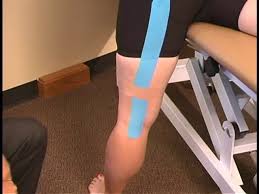
Stretch your hamstring and measure the length of the tape along it. If you’ve previously sought medical attention, If you’ve been informed that just one hamstring muscle is impacted, you should concentrate more on tapping that area.
Procedure: To target the biceps femoris, measure the tape around the belly of the hamstring.
Cut your I-STRIP and make a round the corners.
With no stress on the tape, place your initial base at the ischial tuberosity, or top of the hamstring.
The hamstring is stretched when you bend forward.
Put your I STRIP in a 0% stretch along the biceps femoris belly.
To get back to neutral, stand up again.
Make another, shorter I STRIP cut.
Take out the middle portion of the backing paper by ripping it at both ends of your second I STRIP.
Stretch the middle of the tape to between 50 and 75 percent and place it directly on top of the particular pain region while holding onto the tape with the sticky backing paper still in place.
To stop the tape from recoiling at the ends, lay the tails down loosely.
Before beginning any workout, wait thirty minutes.
Balance taping utilizing K tape for hamstring pain
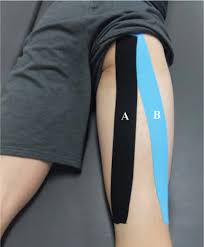
While the patient was in the prone position, 5-cm-wide kinesiology tape was used to do balance taping on the hamstring muscle with about a twentieth stretch to reduce pain and enhance function. Initially, the tape was placed over the semimembranosus muscle, a part of the hamstring muscle, from the ischial tuberosity to the tibia’s medical surface. The kinesiology tape was then used to cover the biceps femoris muscle, extending from the ischial tuberosity to the fibular head.
The VAS pain scores for hamstring muscle soreness during knee flexion and medial right knee discomfort dropped from 6 and 5, accordingly, to 0 and 0, following continuous balance taping. The Tegner Activity Scale level was raised from 3 to 9 lowest tiers of competitive sports allowed: soccer, football, rugby, ice hockey, wrestling, gymnastics, and basketball.
The grade on the manual muscle test of right knee flexion and extension went from fair to normal, and the result of the right leg single jump increased from 47 to 187 cm. The results of the right leg’s active 90-90 hamstring test showed an improvement in hamstring muscle flexibility, going from -51° to -15°. The patient was able to resume playing as a result of these gains.
Traumatic knee flexion injuries and hamstring muscle soreness were treated with the balance taping technique and test procedures. Since the hamstring muscle is primarily responsible for movement during knee flexion, our patient experienced pain. the hamstring muscle before applying balancing taping to verify if making hand contact lessened discomfort when bending the knee. The hamstring muscle was then stimulated tactilely via kinesiology tape rather than hands. This was done by applying pressure to the semimembranosus and biceps femoris. A-beta fibers and other large-diameter fibers are activated by tactile stimulus.
On the other hand, small-diameter fibers like C- and A-delta fibers are activated by nociception. Kinesiology tape stimulates cutaneous mechanoreceptors to improve proprioception. It is believed that A-beta fibers attached to low-threshold mechanoreceptors in the pain area—which are found in the muscles, joints, tendons, and skin—stimulate to reduce pain. Kinesiology tape stimulates mechanoreceptors, which are projected to the brain via A-beta fibers. This stimulation may trigger inhibitory interneurons, preventing A-delta and C-fibers from transmitting pain. Consequently, the pain was reduced by the tactile stimulation that the kinesiology tape of the damaged hamstring muscle offered.
Muscle strength has been claimed to be increased by a variety of skin stimulation techniques, including vibration and touch, as these trigger the gamma motor reaction via the cutaneous fusimotor reflex. using kinesiology taping around the knees to provide tactile stimulation activates gamma motor neurons, increasing attenuation of Ia afferent activity and reducing quadriceps femoris muscle weakness. Similarly, applying kinesiology taping to a damaged hamstring muscle to provide tactile stimulation might cause the gamma motor neurons to fire, causing the muscles to contract smoothly. Rehabilitation of hamstring muscle functions may be aided by smooth muscular contraction. enhancing the knee flexion functions as well as the results of manual muscle tests and the active 90-90 hamstring test, which measures flexibility.
Although the patient experienced pain during knee flexion, patellar and tibiofemoral joint motions should be normal from an arthrokinematic standpoint. A manual contact and movement test is performed to validate any improvements in knee flexion functions and pain reductions before balance taping, which is intended to produce patellar inferior gliding and tibial internal rotation on the tibiofemoral joint, which should happen during knee flexion.
To strengthen patella inferior gliding and tibial internal rotation of the tibiofemoral joint, kinesiology tape was placed twice with roughly 30% to 40% stretch and 50% overlap, beneath the requirements for balancing taping. Patella inferior gliding and tibial internal rotation of the tibiofemoral joint during knee flexion may be induced by repetitive kinesiology taping.
Likewise, the increased stress of the kinesiology tape must cause inferior gliding of the knee joint and tibial internal rotation of the tibiofemoral joint during knee flexion, even if the knee returns to superior gliding and tibial external rotation of the tibiofemoral joint following kinesiology taping. but other research indicated that applying kinesiology tape repeatedly to the depressed scapula and forward pelvis as a result of scapular depression syndrome caused mechanical adjustment, which reduced discomfort.
Therefore, by encouraging patella inferior gliding and tibial internal rotation of the tibiofemoral joint, repeated balancing taping may enhance knee flexion functions. As a result, it was not possible to compare the treatment to other therapeutic approaches. For individuals suffering from severe knee flexion pain and hamstring muscle injuries, balancing taping can be utilized as an adjunctive treatment.
Utilize K tape for Hamstring tightness
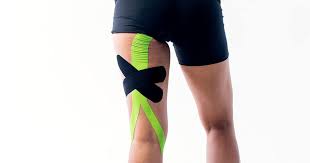
Put one strip of tape on your hamstring, starting just below your glutes and ending at the top, just below the outside of your knee. Using the same method, apply a second piece of tape to the other side. Ensure that your leg remains straight when you apply the tape. Next, exactly below the region of your hamstring that hurts the most, position a smaller horizontal strip of tape. Pull firmly and firmly to apply tension. Just above the region of your hamstring where you experience the most pain, place another horizontal tape strip of the same size. Pull firmly to create tension.
Next, exactly below the region of your hamstring that hurts the most, position a smaller horizontal strip of tape. Pull firmly and firmly to apply tension. Just above the region of your hamstring where you experience the most pain, place another horizontal tape strip of the same size. Pull firmly to create tension.
Application of Y strips
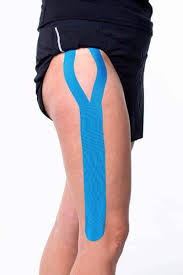
A Y-shaped piece of tape that measures from the knee joint to roughly the center of the buttocks is required. About 7.5 cm of the tape should be divided into two equal reins at the lower portion. You can use our Kintex precut tape and tear the tape strips appropriately, or you can use our Kintex Classic Tape and cut the strips yourself. Making sure to round off the edges of the tape when cutting it will improve its adherence.
Kintex kinesiology tape utilizes an application
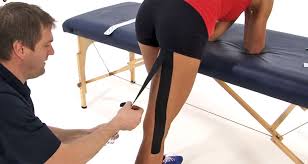
You should first wipe the affected region with alcohol and remove any hair, lotions, and oils to achieve better adherence. The patient leans forward before placing the tape. Below the incisions, rip open the backing paper, and attach this region without dragging just above the rear of the knee, all the way up to the top of the buttocks.
Next, take the first tiny head off of its backing paper and wrap it around the outside of the knee. Repeat in the other direction with the second head. Spreading the tape completely from inside to outside at the end. By doing this, the adhesive is activated and the tape’s stickiness is increased.
Use guidelines for Kintex kinesiology tape: The major effects of Kintex Tape should be felt in the first three to five days after application, and it should be left on for about a week. With the tape on, you can swim, take a bath, shower, or engage in sports. Under the tape, perspiration is even conceivable.
The Spidertech Tap approaches
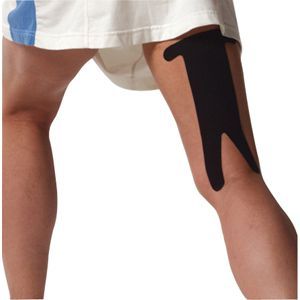
How to Use Spidertech: Take the hamstring kinesiology tape that has already been cut, and tear and fold along the perforations. Before using the tape, make sure to rip all of the perforations.
Place Section 1 over the upper part of your hamstring.
Extend your leg straight and remove that entire part. Remove all of the tape’s stretch and place it on the skin, being sure to keep your fingers where Number 3 is to prevent it from sticking to the tape side.
Rub the tape to release the adhesive after it has been applied to the skin.
Peel off the backing from Section 3 and put it along the skin. Do the same procedure on the contrasting side.
Rub all over the tape to make sure it attaches
Brands and where to buy
These days, kinesiology tape is available in over 50 different brands and kinds, including Kinesio Tape, KT Tape, and RockTape. While some tapes are designed to improve athletic performance, others are intended to treat swelling and lymphedema. The colors of Kinesio Tape, according to its manufacturer, don’t correspond to any chemical or physical changes. These are contingent upon personal inclinations.
Kinesiology tape is available at pharmacies, shops, and some athletic goods stores. They also sell it online. The cost varies based on the merchant and brand, however, some stores may sell a less-priced generic “house” brand.
Factor affects the hamstrings
Overuse: Athletes who engage in sports that involve a lot of running, jumping, or kicking frequently get hamstring tendinitis.
Inadequate biomechanics: You may be more susceptible to hamstring tendinopathy if you run or jump with improper form.
Injuries: Having sustained a hamstring injury in the past may make tendinosis more likely to occur.
The dangers of utilizing K tape for Hamstring
Though there are a few possible risks and adverse effects, KT tape is generally safe and effective. Among them are:
Skin irritation: If the tape is applied for an extended period, the adhesive may irritate the skin.
Reactions to allergens: The tape’s adhesive may cause allergies in certain persons. Symptoms including redness, swelling, and itching may result from this.
If the tape is not applied correctly: it has the potential to break loose or slide off. If the tape is being utilized for stability or support, this could be an issue.
Contraindication of Kinesiology tape
KT taping has certain contraindications. Among them are:
Open wounds: You shouldn’t apply KT tape over an open wound.
Skin conditions: Skin conditions like psoriasis or eczema should not be treated with KT tape.
Allergies: Avoid using KT taping if you have ever experienced adverse reactions to adhesives.
Circulatory issues: Poor circulation should not be treated with KT taping on any part of the body.
Deep vein thrombosis (DVT): Body parts with DVT shouldn’t have KT tape put on them.
Malignancy: It is not advisable to apply KT tape to parts of the body that have cancer.
You should speak with your physician or physical therapist before using KT taping if you suffer from any of these problems.
Things to keep in mind
Additional considerations for KT taping are as follows:
Medical care should never be replaced with KT tape. For a diagnosis and course of treatment, you should consult a physician or physical therapist if you are in pain or experiencing other symptoms.
Serious injuries should not be treated with KT taping. As soon as possible, you should seek medical assistance if you have a major injury.
The usage of KT taping shouldn’t extend beyond two to three days at a time. The tape may begin to irritate the skin after two to three days.
If the KT tape gets loose or comes off, it should be taken off. A fallen or loose tape can irritate the skin or limit the range of motion.
The Kinesio Tape’s Top Seven Advantages
For athletes and serious sports fans, kinesio tape is a useful tool. It has several benefits, the top seven of which are preventative and rehabilitative:
- Get immediate pain relief after an unexpected injury.
- quicker restoration of injured muscles and joints
- Cut down the tap on the similarity of getting hurt.
- Maximize efficiency
- Minimize muscular soreness
- Avoid spasms
- Minimize the chance of being bruised
How can you tell if your hamstrings are strained?
Your level of pain will vary according to the severity of the sprain:
Grade I strain: It comes with some minor discomfort and pain. It typically doesn’t result in any disabilities or limit your daily activities.
Grade II strains are distinguished by a marginally elevated degree of discomfort. It may limit your range of motion, particularly vigorous exercises like jumping and running. It can occasionally result in bruising and irritation.
The most severe type of strain, grade III, might make it difficult for you to walk or even move at all. It also comes with bruising, inflammation, and spasms of the muscles.
How can the tape be removed?
To take off the tape without causing any skin damage:
To loosen the strip, use lotion or oil (such as olive or baby oil) on top of the tape.
Peel off the tape gradually. Don’t take it apart.
To release your skin from the tape, apply pressure.
Instead of pulling the tape straight up and away from you, pull it back against itself. Gently press on your skin as you draw the tape back toward the end tab.
Is it true that KT tape treats hamstring tendonitis?
Regretfully, there isn’t any research on the effects of KT taping for hamstring tendinosis when looking through the National Library of Medicine’s literature. Numerous benefits of KT taping on the hamstring tendon’s activation and flexibility, but none on the symptoms of hamstring tendinosis.KT taping is a treatment that may help with your physical therapy to strengthen the area so that more intensive therapy is possible, even if there aren’t any studies currently demonstrating its efficacy. KT tape is a wonderful choice to evaluate if there are any benefits because it is relatively benign and low risk.
Summary
Kinesiology taping for the hamstring is a therapeutic technique that uses an elastic adhesive tape to provide support and facilitate healing permitting a full range of motion while providing support to the injured region in the hamstring muscle group. The tape is applied in a specific manner to promote proper biomechanics, reduce pain, and improve muscle function.
One kind of elastic tape composed of cotton and nylon is called kinesiology tape. It is applied to the body in a variety of techniques to improve mobility, lessen the pain and swelling following an accident, and stop muscular spasms.
It’s crucial to correctly apply and remove the tape. A physical therapist can guide when and how to use it in addition to helping with this. Individuals with specific medical conditions ought not to utilize kinesiology tape. The overall goal of hamstring kinesiology taping is to improve performance and recovery by treating muscle pain and dysfunction.
FAQs
Who should not utilize kinesiology tape?
Kinesiology tape should not be used by certain individuals, such as those with open wounds, infections, or skin allergies. Additionally, it is not advised if you suffer from diabetes, a stroke, cancer, deep vein thrombosis, or any other medical condition.
Does the use of kinesiology tape improve sports performance?
There isn’t much proof that applying tape to injured areas improves performance in healthy athletes, despite what some have said. While applying tape to injured locations can aid in reducing pain, it’s indefinite whether the pain reduction is important.
Does the use of kinesiology tape have any disadvantages?
If you tape an area too firmly, it might result in blisters or tears in the skin. Tape may not work if it is not applied correctly—that is, with the appropriate stretch and direction.
You should learn how to put the tape on from an expert.
Can you take a shower while wearing kinesiology tape?
You may shower, take a bath, or even go swimming while wearing kinesiology tape because it is water-resistant. You can use a towel to gently pat the tape dry after engaging in activities that result in it becoming wet.
Kinesiology taping: what is it?
Applying elastic tape to muscles and joints to increase support, lessen pain, and enhance function without limiting movement is known as kinesiology taping.
How is hamstring relief achieved with kinesiology taping?
Kinesiology taping can ease discomfort, promote better circulation, strengthen the hamstring muscles, and make it easier to activate the muscles. Additionally, it can help to lessen inflammation and encourage a quicker healing process following injuries.
Is kinesiology taping appropriate for strains in the hamstrings?
Yes, by supporting the affected muscle, encouraging healing, and easing pain, kinesiology taping can help with hamstring strains.
For how long is the kinesiology tape supposed to be worn?
Depending on the wearer and the extent of the damage, the wear time may change. The tape can usually be used for three to five days, or until it begins to be removed
should you work out while wearing the kinesiology tape.
Yes, the kinesiology tape is made to endure moisture and perspiration and is water-resistant. With the tape on, you can work out. To make the tape last longer, put it dry after taking a shower.
How should you wrap the hamstring using kinesiology tape?
For advice on correct application methods, speak with a medical expert or a qualified kinesiology taping practitioner. They can offer advice on the proper taping technique and design based on your unique requirements.
Is it safe to use kinesiology tape?
When used properly, kinesiology taping is generally regarded as safe. To prevent skin irritation or other issues, it is crucial to make sure you are not sensitive to the adhesive and to apply it correctly.
should kinesiology tape take the place of conventional hamstring injury treatments?
Kinesiology taping can be applied in addition to other therapies, such as ice therapy, physical therapy, and rest. For hamstring injuries, it’s important to incorporate it into a thorough treatment regimen.
When should the kinesiology tape be taken off?
It’s advised to take off the tape if you feel any pain, itching, or skin irritation. Additionally, if the tape begins to lose its adhesive strength or tear off, remove it.
should anyone utilize kinesiology taping for hamstrings?
While many people can benefit from kinesiology taping, it’s important to speak with a healthcare provider before beginning any new treatment, particularly if you have any health issues or concerns already.
References
- https://centenoschultz.com/kt-tape-for-hamstring-tendonitis/
- https://journals.lww.com/sjmm/Fulltext/2023/11010/The_Immediate_Effect_of_Kinesio_Tape_on_Hamstring.10.aspx
- Companies, U. (n.d.). SpiderTech Pre-Cut Hamstring Kinesiology Tape. Universal Companies.
- Lee, S. M., & Lee, J. (2018, June 1). Effect of balance taping using kinesiology tape for a hamstring Medicine. https://doi.org/10.1097/md.0000000000010973
- Hamstrings taping (posterior thigh muscles) – Instructions with video. (n.d.). Hamstrings Taping (Posterior Thigh Muscles) – Instructions With Video. https://kintex.de/instructions?tape=hamstrings
- https://www.universalcompanies.com/products/spidertech-pre-cut-hamstring-kinesiology-tape
- https://hamptonadams.com/blogs/guide/the-ultimate-guide-to-kinesiology-tape-for-hamstring-pain
- https://www.verywellhealth.com/kinesiology-tape-in-physical-therapy-2696435

